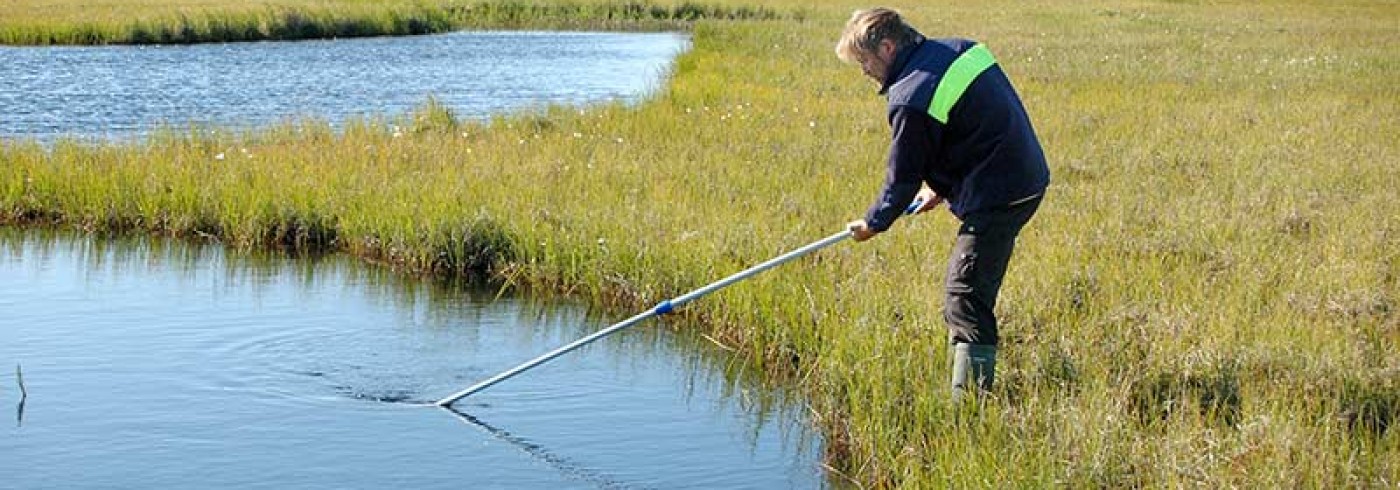Grazing, pigmentation and food-web composition in Arctic freshwater ecosystems
Lakes and ponds are generally very common in Arctic and sub-Arctic regions, constituting an important component of the landscape. They are also vital for many terrestrial organisms, such as birds and mammals, which are attracted to water bodies for breeding and drinking. The majority of Arctic freshwater systems are shallow ponds and the fauna is generally dominated by enormous amounts of zooplankters, such as water fleas (Daphnia), fairy shrimp (Branchinecta), or copepods. Since these organisms are large (1-30 mm) and very abundant, the underwater life is astonishing even for the occasional visitor on the shore. Although many studies have been performed in specific areas and on specific organisms in the Arctic, very little is known about how organisms in Arctic freshwaters interact and how food-webs are constructed. The latitudinal and longitudinal range covered by the Tundra Northwest 1999 expedition offered a rare opportunity both for large scale surveys of food-web composition and tests of specific hypotheses regarding species interactions.
During the expedition I was involved in three different studies regarding processes in Arctic lake ecosystems. One of the studies was a survey of the biological, chemical and physical features of Arctic lakes (A), whereas in the other two studies, lake organisms were used in laboratory experiments on board the ship (B and C).
A. Cross-analysis of high latitude aquatic food-webs (together with Lars Tranvik, Wilhelm Granéli)
In co-operation with aquatic ecologists from several other countries, we sampled a standard data set on the composition of Arctic aquatic food-webs, including: zooplankton, phytoplankton, flagellates, ciliates, bacteria and nutrients from 30 lakes visited. The data is now being processed and will be included in an international data base of about 300 high latitude lakes. One of the more intriguing preliminary findings is that at the northernmost site (the magnetic North Pole) the highest freshwater organism seems to be rotifers, since we found no trace of larger zooplankton or fish in the lakes and ponds investigated. It may be the case that these freshwater systems are off limits for higher freshwater life!
B. Optimization of pigmentation in response to UV-light stress and predation
In contrast to most other lakes of the world, the zooplankters in polar lakes are often brightly pigmented. Some of these pigments have been shown to be effective in protecting the animal against harmful UV-radiation. For example, the water flea, Daphnia, uses the same pigment as humans, melanin, as a sunscreen, whereas another group of zooplankters, the copepods, uses the brightly red pigment astaxanthin. However, pigmentation also makes the animals more vulnerable to predation, which results in pigmented copepods never occurring in lakes with efficient predators, such as fish. The disappearance of pigmented copepods in the presence of fish may be a result of pigmented individuals being eaten and non-pigmented morphs therefore becoming dominant or, alternatively, it may be due to pigmentation being induced by the absence of predators. This means that there may be a trade-off between being protected against harmful UV-radiation (pigmented) and being less vulnerable to predation (non-pigmented). To test this hypothesis, pigmented copepods were taken to 32 aquaria on board. Fish excretion was added to sixteen of these and the fish excretion treatment was crossed with high (UV-light), and low light stress (visible light). As a complement to the laboratory experiment, I assessed the natural variation in pigmentation by sampling copepods from 18 lakes along the route of leg 2 of the expedition.
C. Grazing rates on algae and bacteria by macrozooplankton in Arctic freshwater systems (together with Stefan Bertilsson and Aline Philbert)
The often extremely great abundance of macro zooplankters in Arctic lakes and ponds causes algae to suffer from high grazing pressure. Some of the freshwater systems are mainly dominated by large cladocerans, such as Daphnia (3-7 mm long), which are known to be efficient grazers not only on algae, but also on bacteria. Daphnia surprisingly often co-occur with the large anostracan Branchinecta (10-30 mm). Other important players in freshwater systems are copepods (1-5 mm), which are seldom to be found in great numbers in waters where any of the other two groups dominate. Although a great deal is known about the grazing rate and food selection of copepods and Daphnia, little, if anything, is known about Branchinecta and the possible competition and niche overlap between these three groups. The aim of our study was to fill this gap and assess how Arctic populations of different zooplankton species affect bacterial and algal abundance. We assessed the grazing rates on algae and bacteria in a standardized laboratory study.
Dates
June–September 1999
Participants
Principal investigator
Lars-Anders Hansson
Department of Ecology, Lund University
Sweden

